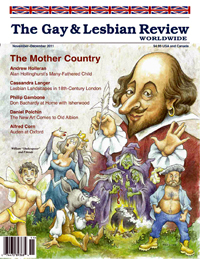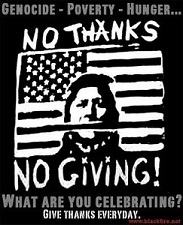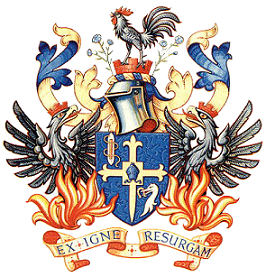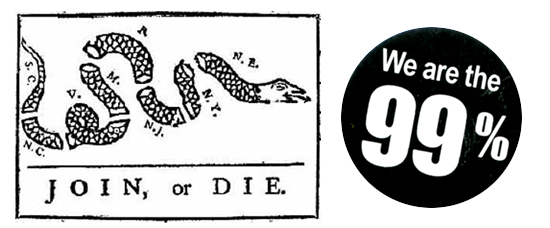Upcoming articles
 This weekend I contacted the editors at the Gay and Lesbian Review Journal of History for possible publication of my article: Exploring the Sexuality of a Founding Father: Gay history in the classroom and how it may reshape how we think about our past. This 3,500 word essay deals with questions surrounding the sexual preferences of Alexander Hamilton, as well as the adoption of SB48 in California's classrooms.
This weekend I contacted the editors at the Gay and Lesbian Review Journal of History for possible publication of my article: Exploring the Sexuality of a Founding Father: Gay history in the classroom and how it may reshape how we think about our past. This 3,500 word essay deals with questions surrounding the sexual preferences of Alexander Hamilton, as well as the adoption of SB48 in California's classrooms.
I was very lucky to get some excellent insights from the gay community and I could not be more excited about the potential for reaching a new audience. I also have an article set for an upcoming issue of Patriots of the American Revolution titled: The Devout Beliefs of an Unbeliever: Thomas Paine’s Age of Reason which presents the secular views of Thomas Paine.
Next, I am seriously thinking about writing an Op-Ed about the fraudulent early American history that is being taught in our nation’s schools. A friend and I were discussing my last post on Native American perspectives when he shared this: “History and perception is all too often set by the victors. I HATE the fact that our schools perpetuate the ‘Indians and Pilgrims, sitting at a picnic table, carving meat and pumpkins in perfect harmony’ ideal and teach it as history. What is wrong with a little honesty? I think our children, who are now bombarded with more and more unvarnished bulls**t from modern society, are capable of a little truth. Perhaps that would be a lesson that would teach us all a little more humility.” I couldn’t agree more.
Myths of the Founding Fathers (FULL) - Michael Parenti
"The delegates to Philadelphia wanted a stronger central power that would (a) resolve problems among the thirteen states regarding trade and duties, (b) protect overseas commercial and diplomatic interests, (c) effectively propagate the financial and commercial interests of the affluent class, and (d) defend the wealthy from the competing claims of other classes within the society. It is (c) and (d) that are usually ignored or denied by most historians." - Michael Parenti
Another Point of View
 This week historians across the blogosphere have been busy posting the traditional Thanksgiving holiday proclamations of presidents George Washington and Abraham Lincoln. These decrees have become the official “go-to posts” for this week, so I have decided to take another angle…
This week historians across the blogosphere have been busy posting the traditional Thanksgiving holiday proclamations of presidents George Washington and Abraham Lincoln. These decrees have become the official “go-to posts” for this week, so I have decided to take another angle…
Historically speaking, Thanksgiving is a unique holiday as perhaps no other celebration on the American calendar is remembered more inaccurately than it. Storybook visions of the early Pilgrims and Native Americans breaking bread together around a giant cornucopia have been implanted into the minds of children for decades. As adults, we eventually discover that this is propaganda, and that the Indians were not all that welcome at the Puritan’s table. The harsh reality is that Thanksgiving, and most early settler’s history for that matter, is viewed very differently by the Native Americans. In fact, the irony of quoting George Washington’s inspirational decree is that he is accused of ordering atrocities against the very people who we like to think liked us.
According to A Thousand Lies: The Native American (compiled by Dee Finney): In 1779, George Washington instructed Major General John Sullivan to attack the Iroquois people. Washington stated, “lay waste all the settlements around...that the country may not be merely overrun, but destroyed”. In the course of the carnage and annihilation of Indian people, Washington also instructed his general not “listen to any overture of peace before the total ruin of their settlements is affected”. (Stannard, David. AMERICAN HOLOCAUST. New York: Oxford University Press, 1992. pp. 118-121.)
In 1783, Washington’s anti-Indian sentiments were apparent in his comparisons of Indians with wolves: “Both being beast of prey, tho’ they differ in shape”, he said. Washington preferred buying Indians’ land rather than driving them off it because he stated that it was like driving “wild beasts” from the forest. His policies of extermination were also realized in his troop’s behaviors following a defeat. Soldiers are rumored to have skinned the bodies of Iroquois warriors “from the hips downward to make boot tops or leggings.” Indians who survived the attacks later re-named the nation’s first president as “Town Destroyer.” Approximately 28 of 30 Seneca towns had been destroyed within a five year period. (Ibid)
Washington and his friend Henry Knox were also the first to propose the cultural transformation of Indians, referred to as the “Americanization of Native Americans.” In doing so they formulated a policy to quote: “encourage the civilizing process of savage peoples.” This movement led to an assimilation effort by the United States Government to transform Native American culture to European-American culture between the years of 1790–1920.
Like much of our nation’s history, Thanksgiving means many different things to many different people. I prefer to look at the holiday as an opportunity for spending time with our families while reflecting on our blessings with gratitude. At the same time, I also acknowledge that historically speaking, it is a mythical representation of a reprehensible period of American history, and means something entirely different to our Native American neighbors.
Posted by ny5/pinstripepress
at 8:29 AM EST
Updated: Wednesday, 23 November 2011 9:02 AM EST
Permalink |
Share This Post
A look at the Huguenots
 A few years ago I penned a casual blog piece that listed the religious preferences of our Founding Fathers. At the time I used a table from adherents.com as I was very impressed with their detailed section on the Religious Affiliation of the Founding Fathers of the United States of America, which presented the faiths of the signers of the Declaration of Independence, signers of the Articles of Confederation, and Constitutional Convention delegates including signers of the U.S. Constitution. One group in particular that piqued the interest of some readers and me was the Huguenots. I was not that familiar with this ‘denomination’ as they were (and still are) truly a religious minority. That said their influence on colonial America is quite apparent.
A few years ago I penned a casual blog piece that listed the religious preferences of our Founding Fathers. At the time I used a table from adherents.com as I was very impressed with their detailed section on the Religious Affiliation of the Founding Fathers of the United States of America, which presented the faiths of the signers of the Declaration of Independence, signers of the Articles of Confederation, and Constitutional Convention delegates including signers of the U.S. Constitution. One group in particular that piqued the interest of some readers and me was the Huguenots. I was not that familiar with this ‘denomination’ as they were (and still are) truly a religious minority. That said their influence on colonial America is quite apparent.
The Huguenot Founding Fathers that were listed were: Henry Laurens, a delegate from South Carolina and signer of the Articles of Confederation; Alexander Hamilton, a delegate from New York and signer of the U.S. Constitution (Note: Hamilton was half Huguenot: He was a practicing Presbyterian and an Episcopalian, but his birth mother was a devout Huguenot); and Daniel Huger, a delegate from South Carolina and Huguenot Representative in First U.S. Federal Congress (1789-1791). No Huguenots are known to have been among the signers of the Declaration of Independence, nor did they serve in the Senate in the First Federal Congress. There were Huguenot colonial communities in what is New Platz NY, New Rochell NY, South Shore (Staten Island) NY, Central PA, Chesterfield County VA, Richmond VA, and Charleston SC. One can assume there were also active churches in South Carolina where Laurens and Huger resided and in New York, where Hamilton lived.
Most Huguenots were originally Calvinists in the Reformed Church who would be considered pseudo-Presbyterians today. Former Lutherans and Baptists also made up a sizable number of those counted as Huguenots. Many came from France’s middle-classes. The Roman Catholic Church and the French government had a long history of persecuting the Huguenots, especially in the sixteenth and seventeenth centuries. Several outbreaks of violence against French Protestants at the instigation of the Catholic Church and the Jesuit Order killed off many within France and drove thousands of others into exile. Their adherence to the Bible as the rule of Christian faith threatened the power of the Catholic Church within France, and many French politicians feared that this would destabilize the country.
Events such as the St. Bartholomew’s Day Massacre forced large segments of the Huguenot population to flee, draining France of much of its middle-class, which contributed to setting the stage for the bloody French Revolution several generations later. The flight of many middle-class Huguenots to other nations like England and the American colonies helped bolster their host nations’ economies at France’s expense. Despite systematic persecution in the 1500’s and 1600’s, there still remains a tiny but significant Huguenot (Protestant) presence within France to this day, accounting for approximately 2% of the French population.
I was able to find an active U.S. Huguenot church, The French Huguenot (Protestant) Church. According to their website:
The French Protestant Church of Charleston was founded in approximately 1681 by Huguenot refugees from the Protestant persecutions in France. About 450 Huguenots had settled in South Carolina’s Low Country by 1700. The first Huguenot Church was built on its present site [Charleston S.C.] in 1687, but in 1796 was destroyed in an attempt to stop the spread of fire, which had burned a large surrounding area. The replacement for the original building was completed in 1800 and dismantled in 1844 to make way for the present Gothic Revival edifice, designed by Edward Brickell White and dedicated in 1845. The church was damaged by shellfire during the long bombardment of downtown Charleston in the War Between the States and was nearly demolished in the severe earthquake of 1886. The present building dates to 1845.
In 1845, the church also purchased and installed a tracker organ carved in the style and shape of a Gothic chapel. Its keys are connected with the pipe valves by a wooden “tracker” or mechanical linkage which responds to the organist’s touch faster than any modern mechanism allows. Its tone is similar to the Baroque organs for which Bach and Handel composed. It was built by the leading American organ builder of the first half of the 19th century, Henry Erben. After the fall of Charleston in 1865, federal soldiers dismantled the organ and were loading it on a New York-bound ship when the pleas of the organist, Mr. T. P. O’Neale, and some influential friends saved it.
This is the only remaining independent Huguenot Church in America. Our church is governed by the Board of Directors and the Board of Elders. Calvinist doctrine, as handed down by the early founders, is very much in evidence today. Our weekly worship service is conducted in English. It is a liturgical service, adapted from the liturgies of Neufchatel and Vallangin dated 1737 and 1772. Communion services are held periodically and are open to all believers. Since 1950, an annual service in French has been celebrated in the spring.
The Huguenot Society of South Carolina also has a website full of excellent resources on Huguenot history. According to their charter, HSoSC was founded in 1885 by their descendants in order to honor and perpetuate the memory of these French Protestant men, women and children.
Source: “Representatives Elected to the United States Congress: The 1st Federal Congress of the United States of America (1789-1791)” in “Religion in the United States Government” by Daniel H., South Carolina, Huguenot Church
Huguenot Crest: The lily cross symbolises the French Huguenots and the historic connection between the Huguenots and Lisburn. The fleur-de-lis, lily, is the symbol of France. The mitre is a symbol for the cathedral that existed in Lisburn for over 300 years. The shuttle and the thread of flax are symbols for the linen industry. The ostrich head with the horseshoe on its beak are taken from the arms of Sir Richard Wallace. The gamecock on the crest is a canting reference to the old name of the town, Lisnagarvey, or the fort of gamesters. The supporters are two phoenix rising from the flames and refer to the fact that the town was burned down and rebuilt twice in its early days. The motto "I will arise out of fire" refers to the same facts.
Are we witnessing another revolution?

“OWS is eerily reminiscent of the run up to the American Revolutionary War. Three ingredients fueled the original American Revolution. The first was egregious British taxation policy exacerbated by the fact that the colonies had no representation in Parliament. The second was the growth of liberalism and its concepts of natural rights and the social contract. Finally, Americans embraced the values of “republicanism” -- in its original form - which criticized both British corruption and the power of the English aristocracy. For eighteenth-century American colonists, democracy was a novel idea, whose influence grew from 1763 onward and culminated with the publication of Tom Paine’s Common Sense. ...Occupy Wall Street indicates that we’re inching towards revolution. We need a twenty-first century Declaration of Independence that addresses three difficult subjects: the size and power of multinational corporations; the wealth of the 1 percent; and the role of money in the American political process. Daunting challenges but not impossible if the 99 percent operate as a Benevolent Community.” – Bob Burnett in The New American Revolution: Occupy Wall Street
 This weekend I contacted the editors at the Gay and Lesbian Review Journal of History for possible publication of my article: Exploring the Sexuality of a Founding Father: Gay history in the classroom and how it may reshape how we think about our past. This 3,500 word essay deals with questions surrounding the sexual preferences of Alexander Hamilton, as well as the adoption of SB48 in California's classrooms.
This weekend I contacted the editors at the Gay and Lesbian Review Journal of History for possible publication of my article: Exploring the Sexuality of a Founding Father: Gay history in the classroom and how it may reshape how we think about our past. This 3,500 word essay deals with questions surrounding the sexual preferences of Alexander Hamilton, as well as the adoption of SB48 in California's classrooms. 





 This week historians across the blogosphere have been busy posting the traditional Thanksgiving holiday proclamations of presidents George Washington and Abraham Lincoln. These decrees have become the official “go-to posts” for this week, so I have decided to take another angle…
This week historians across the blogosphere have been busy posting the traditional Thanksgiving holiday proclamations of presidents George Washington and Abraham Lincoln. These decrees have become the official “go-to posts” for this week, so I have decided to take another angle…  A few years ago I penned a casual blog piece that listed the religious preferences of our Founding Fathers. At the time I used a table from adherents.com as I was very impressed with their detailed section on the
A few years ago I penned a casual blog piece that listed the religious preferences of our Founding Fathers. At the time I used a table from adherents.com as I was very impressed with their detailed section on the 